Brief
“Complexity is a silent killer of profitable growth. Successful companies build a ‘repeatable business model’ that produces continuous improvement and allows them to rapidly adapt to change without succumbing to complexity.” —Repeatability: Build Enduring Businesses for a World of Constant Change By Chris Zook and James Allen
For pioneer firms, getting the Four A’s right is paramount for creating a foundation for farmers to adopt innovations.
However, the challenge of scaling adoption, across villages, regions and countries over and over again, is often an arduous journey. The reality remains that very few firms have achieved widespread mass adoption of their product or service. In reviewing the performance of 100 pioneer firms focused on selling to or buying from smallholder farmers in South Asia and sub-Saharan Africa, we found less than 5% with more than 250,000 customers or 25,000 suppliers in a single year.
So, how can agriculture-focused pioneer firms achieve scaled adoption?
We believe the solution lies with Repeatable Models.
In addition to a solid understanding and application of the Four A’s, a firm must also have a Repeatable Model with the right strategies, processes, teams and supporting systems if it is to be able to handle the challenge of scaling to serve hundreds of thousands or millions of farmers. All too often, firms have attempted to extend their reach before putting these in place, resulting in unmanageable costs and increasing complexity that can thwart the successful scaling of even the most promising innovation. This is the “bad scale trap” that shrinks margins and undermines pioneer firms’ early success.
Companies using Repeatable Models start by clearly defining their core market and their distinctive competencies. Before expanding beyond their core, these companies establish clear operating processes and performance management systems, as well as values and behaviors, and embed them into all levels of the organization. As companies expand to new markets, they adopt systematic entry routines while maintaining the agility to adapt. Throughout the process of scaling, they actively gather feedback from customers on whether and how the Four A’s are in place and rigorously monitor performance metrics. They then use that information to refine their model to maximize the benefits of the Four A’s for the local context. Last but not least, companies invest in the right talent and technology systems to enable the delicate balance of standardization and adaptation as the company grows.
In effect, by getting the Repeatable Model right, pioneer firms will be able to promote adoption of their innovation in an adaptive and increasingly efficient and effective manner, while ensuring sustained, profitable growth: in other words, achieve “good scale.”
Thinking through the elements of a Repeatable Model is helpful for businesses at any stage of growth. But it is most applicable to those that have been operating for a number of years and have started to gain market traction. At that point, the firm is clear on the viability of its business model and the attractiveness of its value proposition. It is now ready to pursue a step change in bringing its product or service to more customers across more areas in a shorter time than ever before. This chapter uses case studies—a cautionary tale as well as several successes—to illustrate how essential Repeatable Models are for helping pioneer firms achieve good scale.
The “bad scale trap”
In 2011, India-based GEWP, maker of the low-cost KB Drip irrigation system, seemed poised on the brink of an exciting growth phase. In November 2007, IDEI, the NGO from which GEWP was founded, received a grant from the Bill & Melinda Gates Foundation to build market awareness and stimulate demand for microdrip irrigation. As a result of this increased awareness, annual sales growth jumped from 40% in previous years to 73% on average from 2008 through 2011. In 2011 alone, some 65,000 farmers purchased KB Drip products, driving revenue to a high of $3.8 million. This success story was well documented in From Blueprint to Scale: The Case for Philanthropy in Impact Investing,1 which ended on a hopeful note for the company as it “push[ed] forward into scaling.”
This is where the story takes a dramatically different turn. GEWP’s revenues fell almost 40% from its 2011 peak to $2.3 million in 2013. At the time of our study in 2014, GEWP had retrenched to Maharashtra and Karnataka with satellite offices in Madhya Pradesh and Tamil Nadu and was in the process of stabilizing its business performance and learning from its earlier missteps.
What happened? The rapid geographic expansion introduced costly complexity at a time when the business was under intense competitive pressure in its original market. As those familiar with India well know, moving across state lines can pose unique challenges. Production scale economies were not possible because the poor transport infrastructure and interstate taxes necessitated new contract manufacturing partnerships in each state. The firm had to make additional fixed-cost investments in new warehouses and hire new salespeople who spoke the local language. As GEWP founder, Amitabha Sadangi, succinctly put it, “In hindsight, entering each new state was like entering a new country.” As a result, the significant increase in salesforce—from 46 in 2011 to 166 in 2012—did not translate to commensurate revenue increases.
During this same period, GEWP faced stiff competition in the states of Maharashtra, Madhya Pradesh and Karnataka, where the penetration of microdrip irrigation was estimated at less than 10% of the addressable market.2 GEWP’s early success had led to copycat competitors, many of whom were selling an inferior product at a lower price. Some of these copycat competitors were even prior GEWP-licensed contract manufacturers who decided to develop their own go-to-market proposition. These manufacturers had worked for more than six years with GEWP and gained knowledge of KB Drip tapes, packaging and supply chain information; they started their own low-cost drip irrigation brands and posed stiff competition in the same market. GEWP was especially vulnerable because it had not been able to bring down unit cost significantly (see Figure 13), and it had little control over the price of polypropylene, which made up more than 60% of the cost of goods sold.
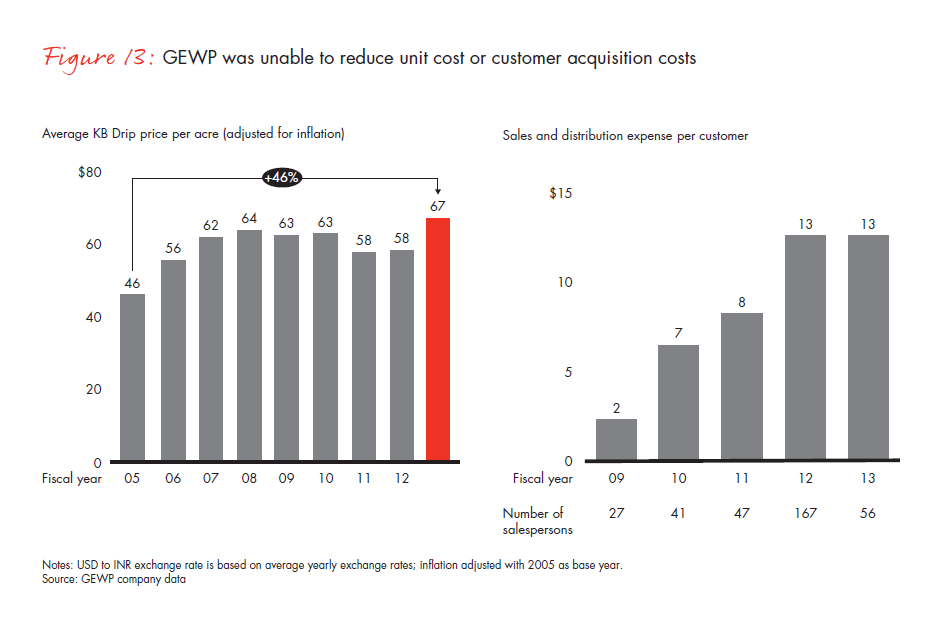
After the marketing blitz of the early years, which had sparked awareness of the product, GEWP had reduced its investment in sustaining its brand presence. Consequently, GEWP’s nonexclusive dealers had a relatively easy time persuading first-time customers to purchase their rival products, which gave dealers higher margins (see Figure 14). In addition, some longer-term users, having improved their livelihoods in part through use of KB Drip, upgraded to costlier, even higher-quality products, some of which were subsidized through a government scheme.
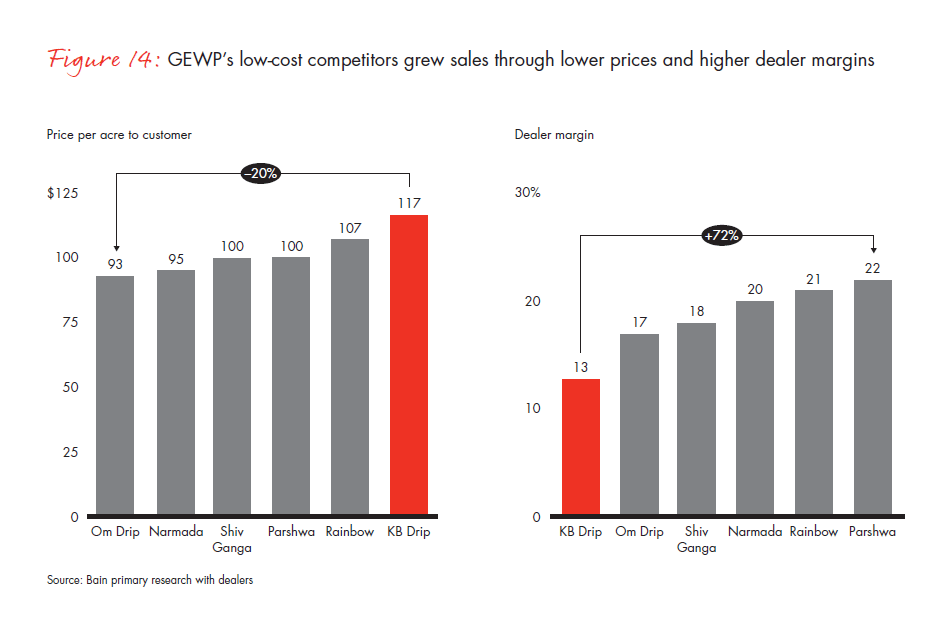
Last but not least, GEWP went through a series of management changes that left the organization without consistent leadership that could help diagnose and address many of these issues.
GEWP, in effect, became a victim of its own success: Significant demand for microdrip irrigation and the emergence of competitors, at a time when management was distracted with entering multiple new markets, eroded its original market leadership position. Ironically, GEWP’s ambitious pursuit of scale ended up undermining its growth, profitability and ability to stimulate mass adoption. And there were signs of collateral damage: At the time this paper was written, the addressable market for microdrip irrigation remained significantly underpenetrated, with no critical mass of leading players, suggesting that a healthy sector has yet to emerge.
GEWP had fallen into what we call the “bad-scale trap”—scale achieved through premature and overextended expansion without the necessary strategies, processes, teams and supporting systems in place. The risk of falling into this trap is especially high in the context of agricultural pioneer firms. GEWP’s case illustrates the complications of expanding not just across state lines but even within a particular state or region. Differences across villages in ecological conditions, infrastructure quality, social structures, language and experience with innovations often require adaptation in product or service design, as well as how a company goes to market. Such adaptations, when not deliberately managed, often introduce costly complexities that challenge the foundations of the pioneer firms’ earlier success. As Chris Zook, leader of Bain’s Strategy practice, has noted, “complexity is the silent killer of profitable growth.”3
What are the implications for the pioneer firm if the path to profitable, sustainable scaling—good scale—is so perilous? The answer lies in building Repeatable Models. The best Repeatable Models are built on the foundation of a company’s greatest successes and they enable the company to replicate these successes over and over again with new customers, new geographies and even new products. But although the need for, and benefits of, a Repeatable Model may be obvious, actually building and executing such a model takes considerable time, effort and patience. In the next section, we will explore how to build Repeatable Models in the markets relevant to pioneer firms.
The foundations for repeatability
Bain & Company has been working with high-performing companies across a range of industries and countries for decades. This experience has helped us identify what is required for companies to sustain their success over time. As outlined in the article “The Great Repeatable Business Model”4:
Really successful businesses build their strategies on a few vivid and hardy forms of differentiation that act as a system and reinforce one another. They grow in ways that exploit their core differentiators by replicating them in new contexts. And they turn the sources of their differentiation into routines, behaviors and activity systems that everyone in the organization can understand and follow. Powerful differentiations deliver enduring profits only when they are supported by simple, nonnegotiable principles and robust learning systems that drive constant improvement across the business.
As we interviewed management teams at the 11 case-study companies, we found that those who were successfully pursuing sustained scale were implementing aspects of Repeatable Models. In this section, we lay out the elements of Repeatable Models, having tailored the framework for agricultural pioneer firms operating in very challenging markets and starting from a smaller base of customers. Our goal is to provide the leaders of pioneer firms with a way to think through and discuss their path to good scale with their management teams, frontline personnel and investors.

Building and executing Repeatable Models: A four-step process
1. Focus: What is your “core,” and how should you prioritize your growth options?
The core. As simple as it sounds, a Repeatable Model starts with articulating a business’s core from two perspectives: which markets you will serve and how you plan to succeed. The first requires strategic choices about “where to play”—which customers, products, regions, channels and value-chain activities the company will focus on. The second refers to the few (usually four to seven) distinctive assets or capabilities that are at the heart of a company’s differentiation. Examples of these could be scale and cost leadership, proprietary intellectual property and technology, superior customer experience and loyalty, speed of new product innovation, marketing or supply-chain management. Essentially, this step defines the parameters of the firm’s addressable market: the target customers for which a pioneer firm is optimized to deliver on the Four A’s.
Penetration. A pioneer firm should focus on penetrating and achieving full potential in its core market. Within the parameters of a core market, there is generally a large degree of sharing of customers, costs, channels and capabilities. This shared platform helps drive scale economies and customer advocacy, which, in turn, strengthens the firm’s competitive advantage. In markets where pioneer firms operate, it may be challenging to accurately assess their penetration of the addressable market, because good market data can be hard to come by. However, even rough estimates on a village-to-village basis can contribute to this base knowledge of how successful the firm is in a given region. To be clear, by “full potential” we mean the optimal performance that can be expected for the delineated market, not the complete coverage of an entire customer base.
Adjacency growth. Pioneer firms should evaluate adjacency options based on their proximity to the core. Bain & Company research across 154 companies’ adjacency moves shows that the further an adjacent growth opportunity is from your core, the less likely you are to succeed. If a new proposed area of your business will require you to sell to new customers in new geographies through new channels, and if doing so will require your staff to develop new capabilities, then the odds of success decline significantly (see Figures 15 and 16). This is all the more true when pioneer firms have had to overcome numerous financial, logistical and HR obstacles to establish operations in the first place.
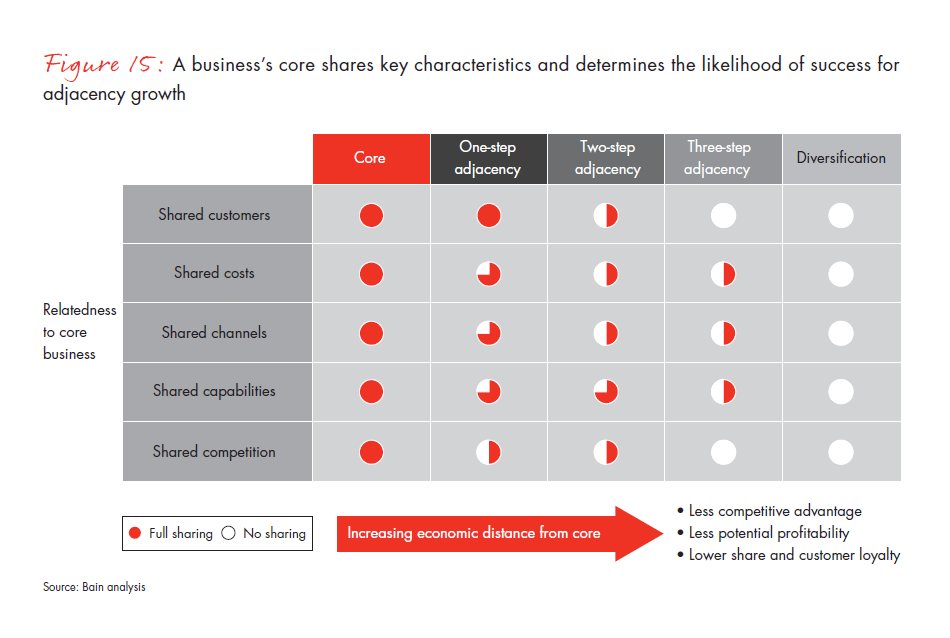
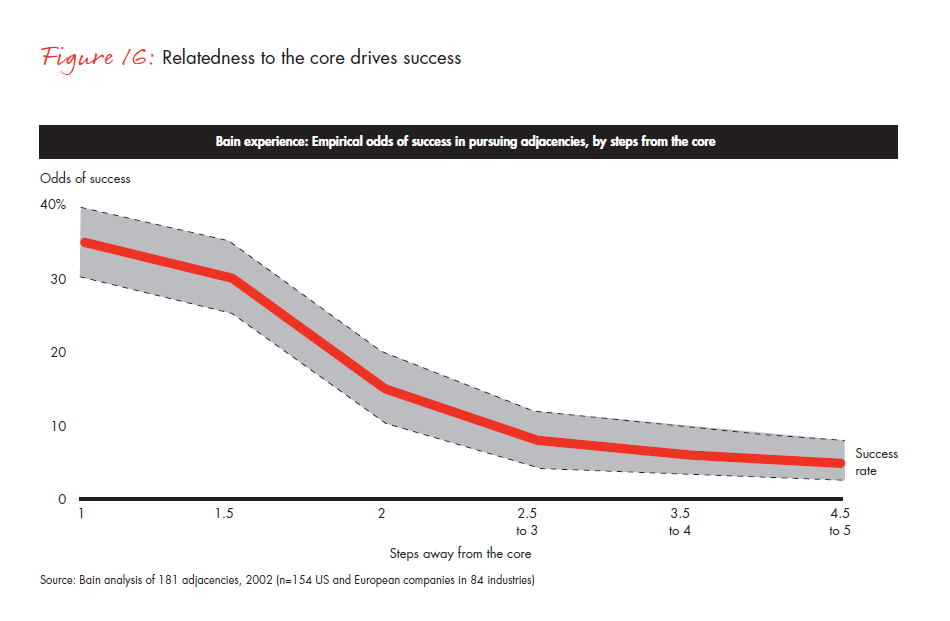
2. Embed: Have you established the routines and culture to consistently translate your strategy into action?
Hardwiring. The strategy of the business should be translated into clear activities through to the front line and consistently executed. Frontline routines have to be codified, and employees need to be effectively trained to ensure that operations are efficient and the customer experience is consistent. This requires near-constant management focus on making sure employees know what the company stands for and are able to execute the routines that make up the company’s operations. Ongoing training and reinforcement help make this goal achievable.
Market entry routines. Ensure that your teams understand how to calibrate the pace of expansion and how to enter and activate new markets. As mentioned, the agricultural pioneer firm’s path to scale has to be conquered village by village, region by region, country by country. Geographic expansion is fraught with challenges. Differences in tribes, languages, social customs, regulations and ecological conditions are just a few of the variables that can make success in a new area difficult to achieve. So, pioneer firms must develop and execute routines that guide market entry at all levels: metrics that trigger consideration of expansion, methodology for evaluating the attractiveness of a new market and an approach for entering and activating a new market that maximizes a firm’s chances of success.
Nonnegotiables. Make clear the values and behaviors that define the culture and founder’s mentality of the pioneer firm. Organization effectiveness is, to a large extent, driven by decision effectiveness, and decisions are informed by the values and behaviors supported by the firm. According to authors Chris Zook and James Allen, this is “a fundamental building block of repeatability, a way of keeping everyone on the same page.
Nonnegotiables translate the most important beliefs and assumptions underlying the company’s differentiation into a few prescriptive statements that all employees can understand, relate to and use as a reference point for making trade-offs and decisions.”5 Particularly given the vulnerability of pioneer firms’ customers, it is critical that the company make very clear the ethos that should inform employees’ actions.6

3. Adapt: Have you set up the feedback and learning systems to continually adapt and innovate?
Voice of the customer. Set up customer feedback systems to ensure that the Four A’s are continually and optimally addressed. Like any business, pioneer firms need to keep the customer front and center. Feedback from customers lets the firm know if customers are continuing to use the product or service, if and how preferences are changing and how competitive value propositions compare. Ultimately, it provides the warning system to the pioneer firm if it is not optimally delivering on any of the Four A’s and informs the necessary corrective actions or structural improvements.
Learning systems. Put in place a few clear performance indicators and a process for monitoring and acting on them to drive continuous improvement. Though this may seem simple, selecting metrics that reflect fundamental drivers of business performance and that enable effective decision making can, in practice, be quite challenging. In an effort to have ever greater visibility, companies can end up drowning in numbers, unable to separate the interesting from the imperative. The cascade of key metrics from the firm to the individual level ensures organizational alignment and provides the basis for rapid learning and adaptation.
Innovation. Pioneer firms must build the capability to anticipate and react to evolving customer needs, competitive threats and new market opportunities. Innovations can take many different forms: new product or service features, new delivery platforms, changes in pricing level or model or process improvements. Pioneer firms need to determine the resource and talent requirements, the necessary levels of investment and investment criteria, the governance model and the critical processes that are required to institutionalize the capacity for innovation. It is important to approach innovation with decisive links to other aspects of the Repeatable Model: delineating the firm’s core market, listening to customers and ensuring that innovations are consistent with the firm’s values.
Voice of the customer and impact measurement Over the past decade, focus on both scale and measurable impact has increased. In the abstract, both of these imperatives make sense. Problems confronting hundreds of millions of people need solutions of the same magnitude. Investments need proof of impact. The more impact per dollar invested or given, the better. The desire for measurable impact is undoubtedly correct; however, the means by which any such initiatives or requests are implemented are vitally important. Too often, measurement requirements are enforced from the top down, with insufficient knowledge of pioneer firms’ realities and constraints in collecting these metrics and, just as important, consideration of the value that such data will offer to the firm. This point was made often in our interviews with pioneer firm management. Any data initiative involves balancing the costs of collection and the perceived insights derived from metrics. Fortunately, a growing number of initiatives and tools are available to make impact measurement both easier and more valuable to all stakeholders, creating a range of demonstrable examples showing what can be achieved. Acumen’s Lean Data Initiative is one such example. It uses a range of mobile technologies and focuses on natural company or customer touch points while using a range of smart survey methods (including the Progress Out of Poverty Index used in the research for this study) to improve the efficiency and effectiveness of data collection. Similarly, common business and customer metrics long used by some of the best-run corporations to evaluate and improve performance may also hold significant promise. A good example of such metrics is the Net Promoter ScoreSM (NPS®), which measures the strength of customer loyalty and advocacy for a product, service or organization.7 We believe that the potential relevance and applicability of NPS in the context of agriculture pioneer firms, which rely so significantly on word of mouth among farmers to encourage broader adoption of their innovation, could be extremely significant. This simple metric, and the broader loyalty system built around it, helps firms identify the drivers of advocacy and detraction and pinpoint the product or service elements and business processes that need to be adjusted to earn deeper customer loyalty. The connection between customer loyalty for a firm’s product or service and its impact on customers’ livelihood is one that demands further study. There is significant opportunity to explore how NPS can be effectively applied to low-income customers and provide pioneer firms with a more useful tool to drive insight, improve performance and create impact. |
||
4. Invest: Are you investing in talent and systems that will set you up for long-term growth?
Capital. Pioneer firms need to secure the optimal type(s) of capital at the right time to fund growth priorities. As written in From Blueprint to Scale: The Case for Philanthropy in Impact Investing, philanthropic capital plays a key role in filling the pioneer gap. Grants can be especially valuable in the Prepare stage to help new companies activate a new market, and they can also be successfully deployed to develop parts of the value chain—building the skill base in farmer communities, creating better routes to market, conducting research and development that can be used by the sector—that don’t exist, given the underdeveloped state of a market. Similarly, a small but growing number of impact funds are increasingly willing to take on higher-risk investments that have a greater probability of delivering outsized social returns, even in cases where the financial upside may not be high enough for more mainstream providers of capital. Part of the complexity of moving from the Blueprint to Scale phases is managing multiple stakeholders’ requirements and building the core capabilities and governance of the firm, along with the clear path to profitability that mainstream investors expect.
Systems. Build scalable technology platforms to enable efficient processes and information sharing. As is the case for any business, appropriate technology that is scalable and widely available can increase transparency and efficiency across an organization and drive faster, more informed decisions. Pioneer firms need to make sure that technology serves their purposes and is not overly complex or ill-suited to the conditions in which they work. Meeting these criteria can significantly enhance their efforts to reach more customers.
Talent. Invest ahead of growth in the leadership team and “talent machine.” Scaling a pioneer firm can often require a different set of leaders than the initial founding team. Furthermore, such companies need ever more human capital, from senior executives to frontline employees, to run the operations day in and day out. Pioneer firms must invest ahead of revenue growth to attract the kind of talent that can help grow and sustain the company. Providing incentives like employee stock options can be one way to attract management personnel who may have years of experience at larger firms but, accordingly, larger salary expectations.
Admittedly, in many contexts, options may not work given the limited precedent for this form of incentive in this field. Furthermore, many more-senior employees may be hesitant to spend significant time in rural areas if they do not have prior experience there. Thus, many companies have to overinvest in finding senior personnel who are at the right career point to make a significant change and have a passion for contributing to the broader development of the country. For frontline employees, there must be an increasingly standardized and efficient system that is able to effectively screen and evaluate prospective employees, bring them into the organization and train them to quickly carry out the responsibilities for which they are hired. However, as pioneer firms expand and professionalize the organization, they must pay special attention to maintaining its unique culture and nonnegotiables.
In summary, Repeatable Models enable companies to reduce complexity, collapse the distance between CEO or founder and the front line, turn speed and adaptability into competitive advantages and build a solid foundation for rapid, sustainable growth. The Repeatable Model framework is a continuous process of appraisal and learning (see Figure 17). Taken as a whole, the framework provides pioneer firms with a guide to the key elements of their business that must be in place to achieve good scale. Few pioneer firms serving smallholder farmers excel at all elements.
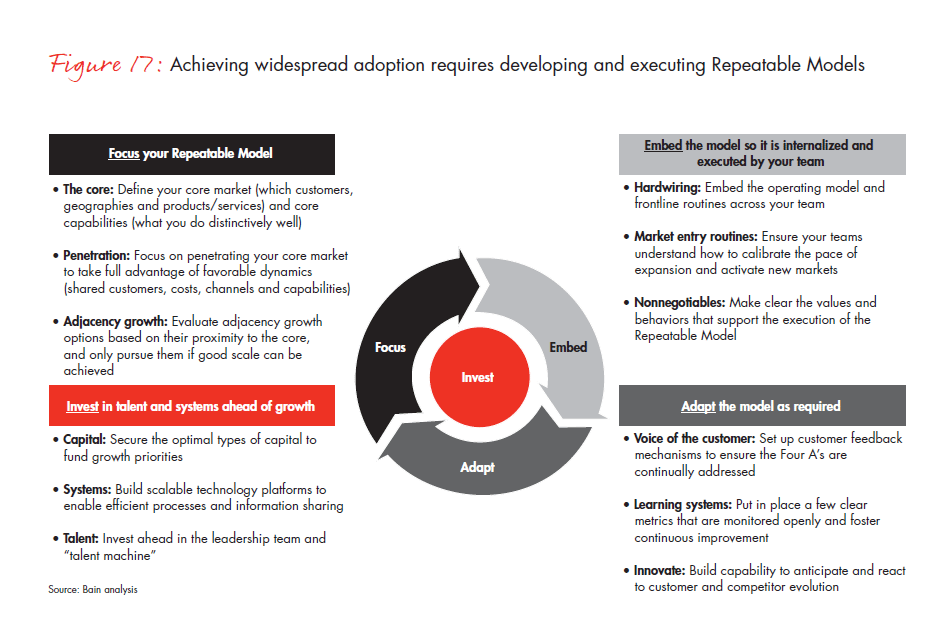
Following are detailed profiles of two organizations, Juhudi Kilimo and OAF, and a brief overview of Sidai. These profiles highlight the ways in which these businesses have developed aspects of Repeatable Models to build good scale.
Profile: Juhudi Kilimo
Juhudi Kilimo (meaning “agricultural efforts” in Swahili) was founded in 2004 as an agribusiness initiative within K-Rep Development Agency, an R&D-focused microfinance NGO. By 2009, it had become an independent for-profit social enterprise with the mission of providing loans and training to rural smallholder farmers.
Juhudi Kilimo provides asset-backed loans and basic finance and agriculture training to smallholder farmers. Unlike traditional microfinance, which primarily provides loans for working capital, Juhudi Kilimo finances specific agricultural assets that offer ongoing income for farmers, like a dairy cow or a motorcycle used to carry milk from a farm to a processing center. These assets are insured to protect both the clients and Juhudi Kilimo from business losses. The company reduces farmers’ risk of further indebtedness by using the assets as a form of collateral in case of default. Each asset is verified to have been purchased by the customer within one month of the loan having been provided.
As with much microfinance around the world, groups of clients (typically groups of five) co-guarantee their loans and support one another through independent joint liability groups with oversight from Juhudi Kilimo’s loan officers. Farmers in these groups meet to share ideas and encouragement, learn about new products and services and organize for access to better pricing and markets.
Focus
Juhudi Kilimo’s strategy is grounded in a clearly articulated core market: providing financing for income-generating assets to smallholder farmers in Kenya (see Figure 18). It differentiates itself from other MFIs by focusing on asset-backed group loans and providing them at lower interest rates and “at the customer’s doorstep,” with faster processing and approval times and customer training to enhance productivity. These differentiators are enabled by Juhudi Kilimo’s relatively low cost of capital (achieved by negotiating lending funds from low-cost providers like the microfinance platform Kiva) and by cloud-based management information systems and a productive workforce (which manage high customer loads while maintaining high repayment rates).
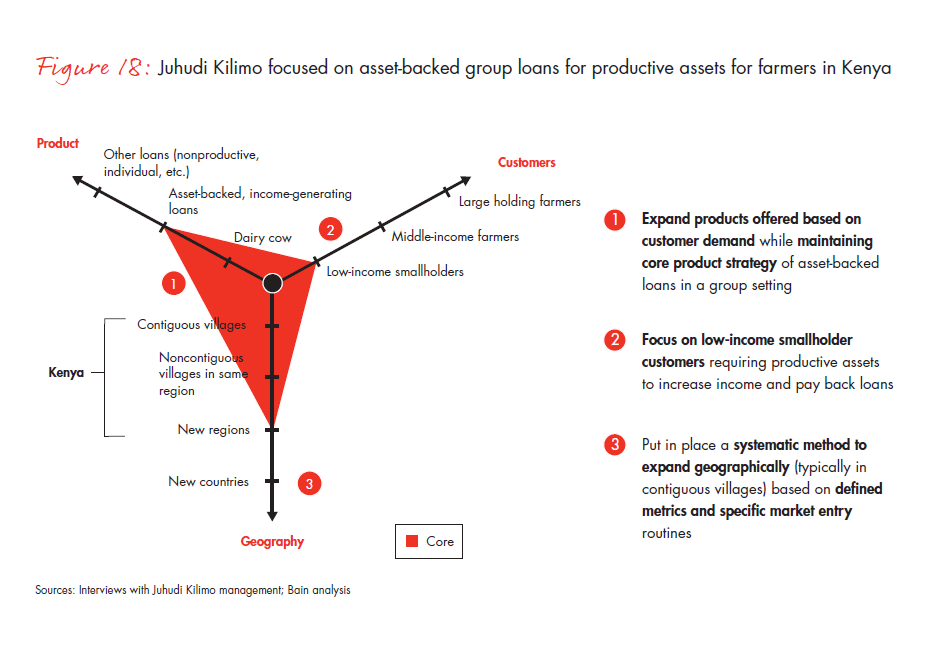
The company focuses on penetrating its core market to take full advantage of favorable market and competitive dynamics—that is, shared customers, costs, channels and capabilities. Once a branch is established, the company focuses on increasing penetration in that area based on key operating metrics. The branch must get to an outstanding portfolio of $450,000 with approximately 300 active customers per loan officer, four or five loan officers and a customer repayment rate of 98%.
The company has slowly expanded its product offerings based on customer research while maintaining its core product strategy of providing asset-backed loans to joint liability groups. Its original loan product was specifically for dairy cows. The milk provided ongoing income with which to repay the loan and increase the family’s income. Seeing gaps in the value chain, such as in the transportation of milk from the farm to a processing center, the company expanded into a close product adjacency, providing loans to farmers who wanted to buy a motorcycle to transport their milk. Though customers have increasingly requested individual loans or loans for education or home expansion, Juhudi Kilimo has remained focused on providing loans only for assets that directly and quickly generate income. This decision minimizes potential product complexity and helps employees and customers develop a clear idea of what the business stands for and what value it brings.
Repeatable Models and microfinance It is no surprise that, of the companies we studied, the two that had the most elements of the Repeatable Model framework in place were also involved in aspects of microfinance. The most widely and successfully scaled service tailored to low-income customers has been microfinance. There are many reasons for this, including the broad applicability of the service and the attractiveness of cash that is provided at a fraction of the interest rates offered by alternative lenders. However, another reason is the significant investment by many organizations around the world to codify best practices for the business model. The Grameen Model that came out of the Grameen Bank in Bangladesh provided a prototype that has been implemented across dozens of countries over the past two decades. The overall organizational structure—from the head office to the branch office, the number of clients per loan officer and the general model for forming and facilitating joint liability groups—was well documented and shared around the world to help other organizations increase financial inclusion. The Consultative Group to Assist the Poor, a “global partnership of 34 leading organizations that seek to advance financial inclusion,” funds and supports research and publications on a range of topics related to customer segmentation, policy, mobile platforms and financial-inclusion product development. Organizations such as Accion International, Women’s World Banking and the Foundation for International Community Assistance provide direct support and coordination across a network of MFIs. The similarity of each organization’s fundamental model allows for valuable operational interventions that increase efficiency and effectiveness. Given the diversity of local environmental conditions, the applicability and expected advantages differ for an agriculture company from place to place. The kind of operational best-practice sharing possible with microfinance is more challenging when it comes to seeds, fertilizer, drip irrigation or the artificial insemination of cows. However, there is significant opportunity to increase the level of codification and best-practice sharing across agriculture-focused companies. Studying and codifying best practices in other industry verticals, whether within agriculture or more broadly, support greater understanding of effective business models to serve the poor. |
||
Embed
To embed its business model across the organization, Juhudi Kilimo established a systematic, standardized recruiting system to ensure that hiring standards would be maintained as employee numbers increased. This system comprises clearly defined job descriptions, standardized application screening criteria used by recruiting agencies and final-round interviews with senior management at Juhudi Kilimo’s headquarters.
Training at Juhudi Kilimo is extensive. New loan officers shadow seasoned officers for three months before taking on and growing a portfolio of their own clients. The HR department also published process manuals to disseminate best practices across the organization and created a mentoring program that matches each mentor to two employees. Finally, the company is in the process of establishing Juhudi Academy, which will offer a formalized training program for continuous learning to new and current employees. Once it is launched, the academy will use a defined syllabus and have a “train the trainer” emphasis as the company continues to grow.
Juhudi Kilimo uses a bottom-up approach to goal setting, guided by what the head office believes is achievable given access to capital and talent. Its overall goal of serving 100,000 customers by 2015 was defined in 2013 with input from all branch managers. The company sees itself as a collection of operating units and understands that its success is predicated on the ability of its individual loan officers to acquire and retain customers. To that end, it systematically tracks individual field officers’ progress toward weekly and monthly goals.
In addition to defining metrics to measure penetration in existing markets, Juhudi Kilimo established a step-by- step expansion process for establishing satellite offices in new markets and, over time, developing them into branch offices. As a branch begins to reach performance levels that indicate it has achieved nearly optimal penetration (its “state of the core” metrics), Juhudi Kilimo’s marketing team evaluates branch managers’ proposals for which new market to enter. These new markets must lie within 45 kilometers of an existing branch to ensure easy access by loan officers, who typically travel by motorcycle. Proposals contain estimates of demand, as well as assessments of basic infrastructure such as roadways and the general security of the area. A more detailed study follows to test the feasibility of opening the proposed new satellite. The team meets with stakeholders associated with the potential new location, conducting focus groups with smallholder farmers, understanding financial institutions’ activities in the region, assessing the capacity of local dairies and meeting with government agencies to explain what Juhudi Kilimo does and how farmers benefit from its services. Figure 19 shows Juhudi Kilimo’s current operational footprint.
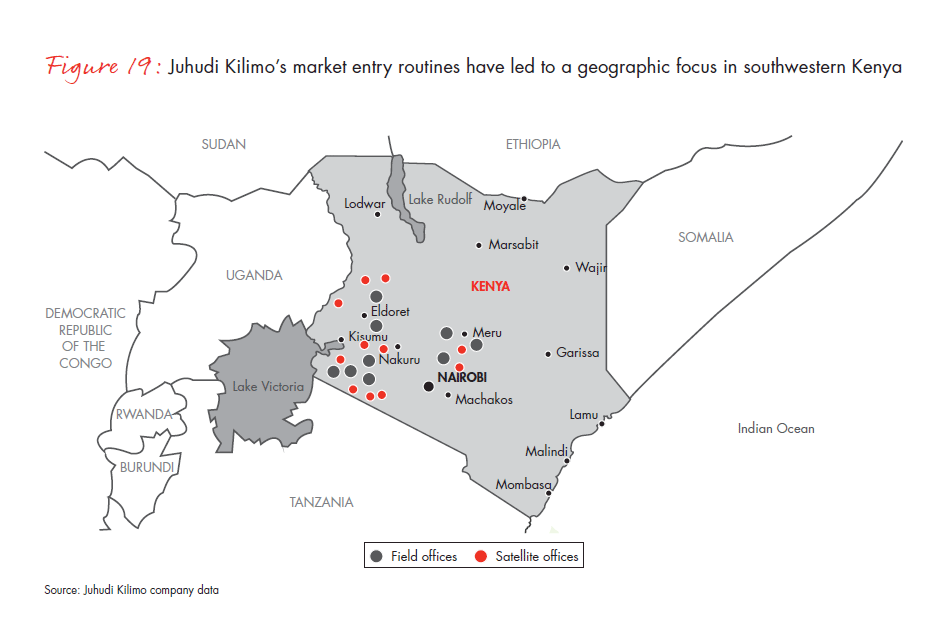
One of the key elements the team assesses is the potential demand in the new market. Signs of potentially high demand include the presence of smallholder farmer clusters, gaps in sources of financing for these customers and existing government programs serving farmers (which could generate initial leads to already formed groups). The team also tests for the presence of support systems in the targeted location, such as sufficient basic infrastructure, sufficient purchasing capacity, value-chain support (including agrovets and breeders for dairy cows) and the potential to partner with ministries, cooperatives or other stakeholders. If a new site seems attractive, the team generates ideas for how to tailor marketing methods and products (such as whether the primary income-generating asset will be cows or poultry). These activities are all aimed at making sure that the drivers of adoption, the Four A’s, are in place.
As CEO Nat Robinson explained, “When we started, we set up offices all over Kenya. A more organic approach is being used now, where current offices are used as the base from which satellite offices are created as demand increases.”
The expansion process follows these steps:
1. Create an initial proposal and conduct a feasibility study. A branch manager’s proposal to enter a new market is created and analyzed by the marketing team for feasibility and attractiveness.
2. Build an initial portfolio and set up a satellite office. A loan officer from the parent branch begins making trips to the new location and building a loan portfolio there. When the portfolio reaches $90,000 to $100,000, the satellite office is established.
3. Activate the market. Juhudi Kilimo activates the new market (i.e., raises awareness of its offerings) by broadcasting radio advertisements in local languages, during which current clients provide testimonials, branch employees describe the company’s vision and products and listeners are invited to call in with questions. The company sends vehicles with the company’s logo and loudspeakers to the area and sets up tents to hand out flyers and generate leads. In addition, the sales team, accompanied by a current client, walks from village to village to meet prospective customers. The Juhudi Kilimo team explains what the company has to offer and the client shares his or her personal experiences of working with Juhudi Kilimo.
4. Establish a new branch. When the satellite office’s loan portfolio reaches $140,000 to $150,000, a branch office is established. Business development officers and administrative personnel (finance and information technology support) are added as needed.
By following these standardized expansion routines, Juhudi Kilimo has expanded to 20 branch offices across Kenya.
Adapt
Juhudi Kilimo has put learning systems in place to adapt its business model as required to continue increasing its scale. It collects and analyzes data on key metrics, such as loan amounts disbursed, the number of active borrowers, the number of new loans by type and portfolio quality (rate of client repayments). The company uses salesforce.com to collect the data in real time from tablet computers provided to every loan officer. Juhudi Kilimo reports performance on those metrics on weekly scorecards and discusses branch-level performance during weekly meetings led by the COO.
Performance on key metrics is used to determine incentive pay for branch managers. Performance below goals is elevated to branch managers and then to area managers, with an emphasis on determining the root causes and tailoring coaching, training and other programs to improve performance.
To further support learning, Juhudi Kilimo uses a short message service (SMS) for mobile phones to survey current clients. The survey covers general satisfaction, the assets clients have acquired, how Juhudi Kilimo’s services have affected their income and what help they might need to increase their productivity. Responding to these surveys is free for customers and costs Juhudi Kilimo just $0.40 per response. Juhudi Kilimo typically achieves a response rate exceeding 30% within two days of sending out the surveys. It uses the responses to identify any operational issues and to tailor the technical support it provides to farmers. Radio call-in shows further enable Juhudi Kilimo to gather questions and feedback from potential customers. The marketing department ensures that all questions are answered live on the air or are compiled and conveyed to the respective branches for discussion with joint liability groups.
Juhudi Kilimo also seeks to continually improve its approach. For instance, it created Juhudi Labs to test new product and process innovations, such as providing individual loans and other products (including dairy cooling units and warehousing) for the agricultural value chain. The branch managers also convene regularly to share best process and administrative practices across the organization. To explore potential new products that come with a higher risk level and longer payback periods, Juhudi Kilimo sources funding from grant-giving foundations.
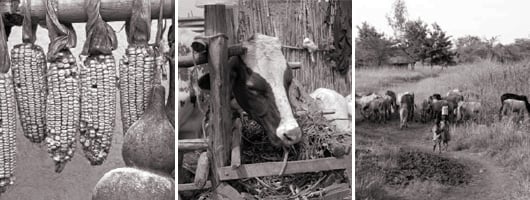
Invest
Juhudi Kilimo invested early on in high-caliber, locally sourced leadership talent. Nat Robinson, the current CEO, made it a point from the outset to localize his senior team and brought in seasoned executives with significant relevant experience. For instance, Shadrack Mutunga, CFO, has worked for 14 years in the microfinance industry, including stints with Kenya Women Microfinance Bank, Remu DTB and World Relief. Nancy Butama, chief human resource officer, has more than 10 years’ experience in healthcare insurance, including managing an HR department for more than 450 employees. Benjamin Kimosop, COO, has extensive experience within Juhudi Kilimo, having been promoted from business development officer to branch manager to regional manager before he became COO. He was formerly an area manager with SISDO, a larger Kenyan MFI. And Mujeni Aseli, chief marketing officer, previously worked as a senior brand manager with the Coca-Cola Company across countries in southern Africa.
To manage high client loads and repayment rates, Juhudi Kilimo maximized staff efficiency by adopting a cloud-based management information system to support quick processing and reporting of only a few days. This scalable IT system helped ensure efficient tracking of critical performance metrics. The system was designed to accommodate a five-year strategy and to expand to cover as many as one million users. One platform runs core operations and the other is used to manage leads generated from various sources. Members of the IT team visit each branch monthly to diagnose and fix any problems.
Juhudi Kilimo’s loan disbursements grew from just $1 million in 2009 to $6.3 million in 2013. Meanwhile, the number of smallholder farmers it served expanded from almost 4,800 in 2011 to nearly 14,500 in 2013, a 202% increase. From 2011 through 2013, the number of employees more than doubled from 43 to 98. Impressively, from opening roughly one branch office a year since 2004, Juhudi Kilimo opened four branch offices in 2013. At the time of writing, Juhudi Kilimo is expecting significant growth in 2014 and is on track to add seven branch offices within the year (see Figure 20).
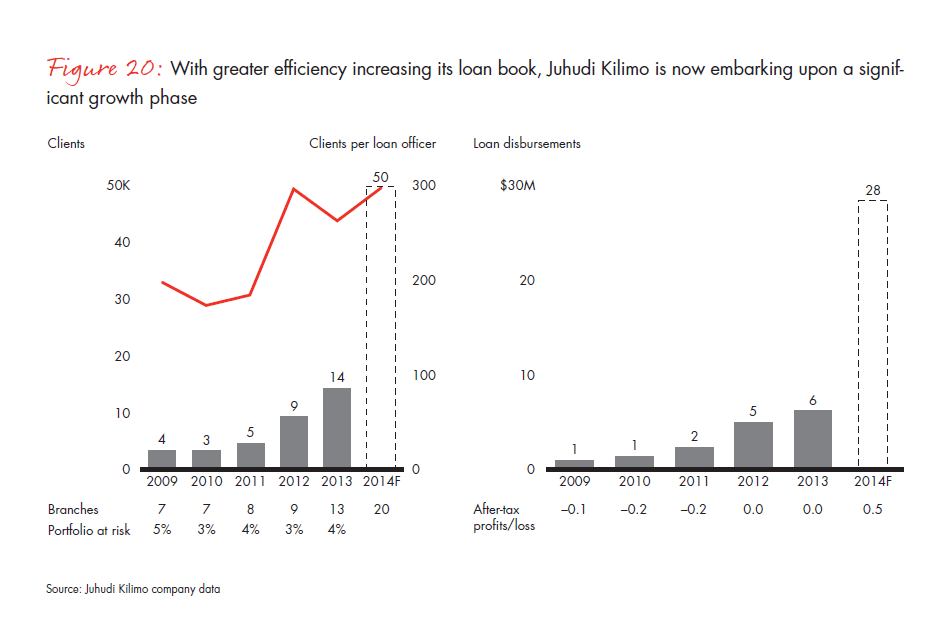
Profile: One Acre Fund
One Acre Fund is a nonprofit based in East Africa that supplies smallholder farmers with a complete bundle of financing and training services to reduce hunger and poverty. The organization invests in farmers to generate a permanent gain in farm income by distributing packages that can include seed and fertilizer (depending on the country), financing for these farm inputs, agricultural training and market education to maximize harvest profits. OAF operates in villages throughout Kenya, Rwanda, Burundi and Tanzania and delivers services within walking distance (generally less than five kilometers) of the 180,000 smallholder farmers it serves.
The organization facilitates activities and transactions at each part of the farming value chain, from seed sourcing to education on selling output. On average, member farmers realize a 100% return on their investment and significantly increase farm income on every planted acre.
OAF has mastered many elements of the four-step process for building and deploying a Repeatable Model.8
Focus
OAF’s core offering is to provide agricultural inputs on credit to within walking distance of low-income smallholder farmers (see Figure 21). The company holds weekly training sessions with its farmers to ensure they are using optimal growing techniques to get the most from the inputs. To reduce complexity, its loan packages are standardized across each country where it operates. Thus, the core concept of its offering remains the same, even if each market’s package may have minor modifications, such as the types of seeds or fertilizers.
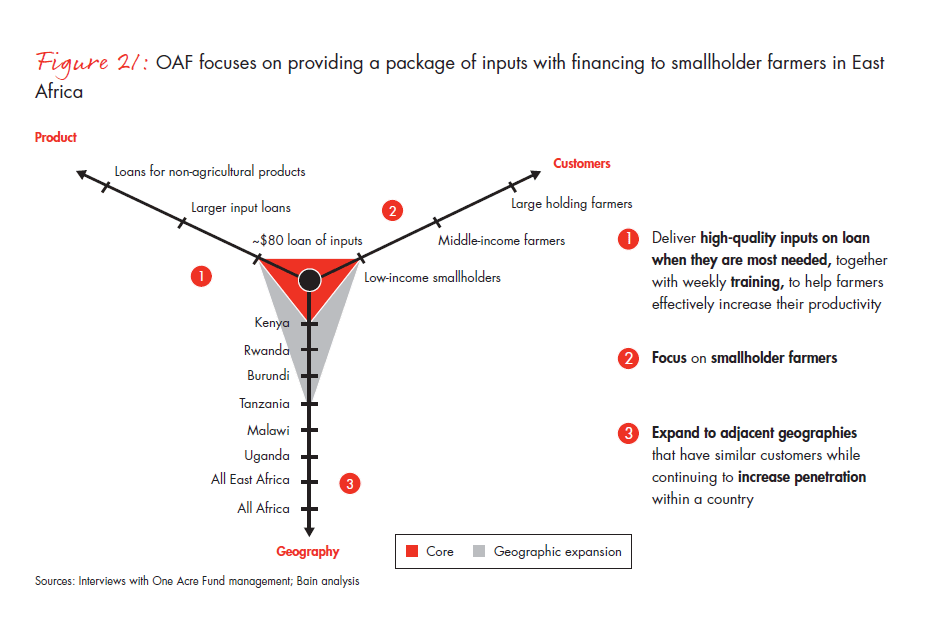
The organization differentiates its product offering by always delivering high-quality inputs in time for the planting season and by providing in-person training that helps farmers use the inputs correctly to increase their productivity. To ensure the quality of inputs, the organization takes delivery directly from manufacturers and deploys a stringent quality-control process. It also ensures delivery of inputs to farmers no later than a few weeks before planting season begins. The groups of 10 to 20 farmers meet weekly with a field officer, who teaches effective farming practices.
OAF has expanded to adjacent geographies that have similar customers in terms of their income, growing techniques and plot sizes, while deepening its penetration into its original market of western Kenya.
Embed
To hardwire its Repeatable Model across the organization, OAF has built systems aimed at managing complexity. It rigorously monitors performance across a number of metrics (key performance indicators, or KPIs) that have been grouped into three categories central to OAF’s mission: impact, scale and sustainability. All major business decisions are evaluated through the lens of a decision’s effect on these three categories. Field officers receive weekly updates on the performance of their loan portfolio and the repayment amounts and rates pertinent to the farmers they represent.
OAF has further controlled complexity by standardizing people management and operations. To illustrate, in each country where OAF operates, field-officer recruiting is standardized, including criteria for selecting new hires and the use of templates for screening job candidates. Newly recruited field officers go through a comprehensive, four-week training program supported by a detailed, 110-page crop-training manual that OAF updates frequently to reflect newly learned best practices from the field (see Figure 22). The program covers OAF’s vision, mission and organization and includes job shadowing with more experienced field officers. Participants learn key elements of crop training, such as how to lead meetings and how to teach land preparation, planting monitoring, weeding, top dressing and pest and disease control. Field officers in training are given memorable takeaways, reference cards, for example, with illustrated planting instructions that they can use in consultations with customers.
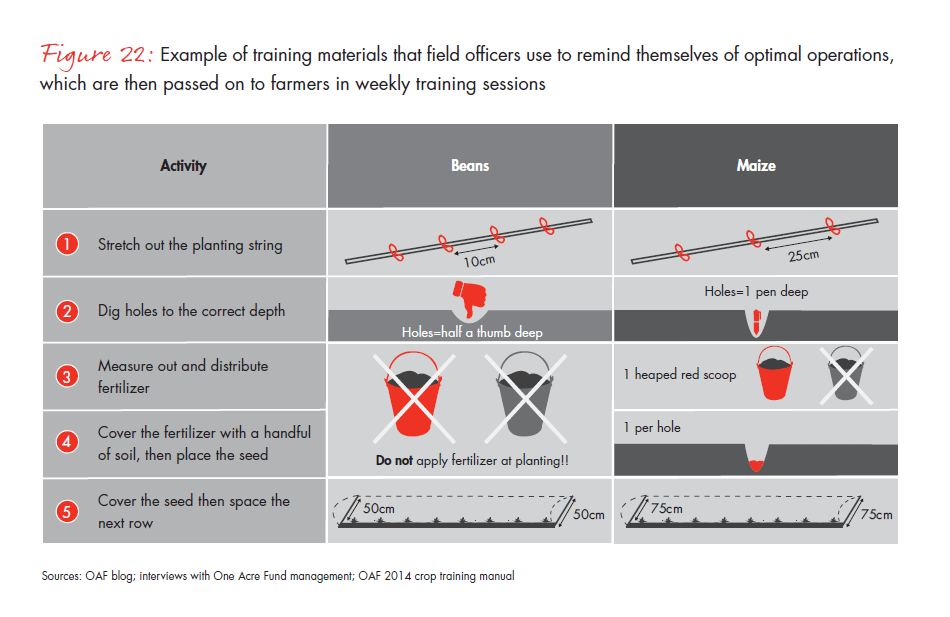
A central procurement organization purchases inputs directly from suppliers, and all purchases go through a rigorous quality inspection. OAF’s logistics team plans three-week delivery periods more than 10 months in advance.
In Kenya, OAF has become similarly disciplined regarding market entry. Previously, OAF created “islands” away from its geographic center and expanded from those hubs. Today, it expands to areas contiguous to its current operations, splitting districts in half when necessary to meet its scale goals. This new, contiguous expansion approach has dramatically reduced OAF’s distribution costs. Moreover, it has eliminated the need to relocate field officers to areas with which they are not familiar. Officers can use word-of-mouth publicity and customer advocacy from nearby communities where OAF has achieved penetration. And because the contiguous markets are well understood and tested, risks and learning costs have been minimized.
In terms of its international expansion, OAF has a codified methodology that starts with secondary research of a potential target country, with an eye toward identifying opportunities to make a positive impact on smallholder farmers’ income. Impact checklist items include small farms, staple crops with established markets, low yields and low use of fertilizers and improved seeds. Operations checklist items include security risk, one million to two million serviceable households, low prevalence of corruption and sufficient infrastructure to support operations and growth.
Conversations with OAF’s cofounder Andrew Youn reveal that the idea of focusing on penetration before expansion was a key part of the organization’s early years. “We thought about growth in the way that retail companies do,” Youn said. “We could grow our sales at existing ‘stores’ or we could build new ‘stores.’” OAF focused much of its early refinement of the model in Kenya on developing the metrics that would indicate whether the firm had sufficiently grown its existing operations before expanding to new areas. The organization now has a clear hierarchy of growth: first “growing in” by increasing client density within existing areas, then “growing out” with new areas within a current country operation and, finally, new country expansion. Operational resources are allocated according to this prioritization.
OAF also conducts primary research on customers to understand the needs of specific farming communities in target regions. Questions include whether farmers see the value of OAF’s offerings, whether they are willing and able to pay on time and whether OAF’s methods could lead to higher yields for the farmers.
The organization typically has two to three countries in a trial phase, with the goal of expanding into a new country in Africa every 18 months. From its roots in Kenya in 2006, it entered Rwanda in 2007, Burundi (which borders Rwanda) in 2012 and Tanzania (which shares borders with Kenya) in 2013. It is currently piloting a project to explore the potential of expanding in Malawi and Uganda.
To further embed its Repeatable Model throughout the organization, OAF has established nonnegotiables for its people that include putting the “farmer first” in everything it does (see Figure 23). The organization makes it clear that the farmer is the boss—the customer that every field officer must listen to.
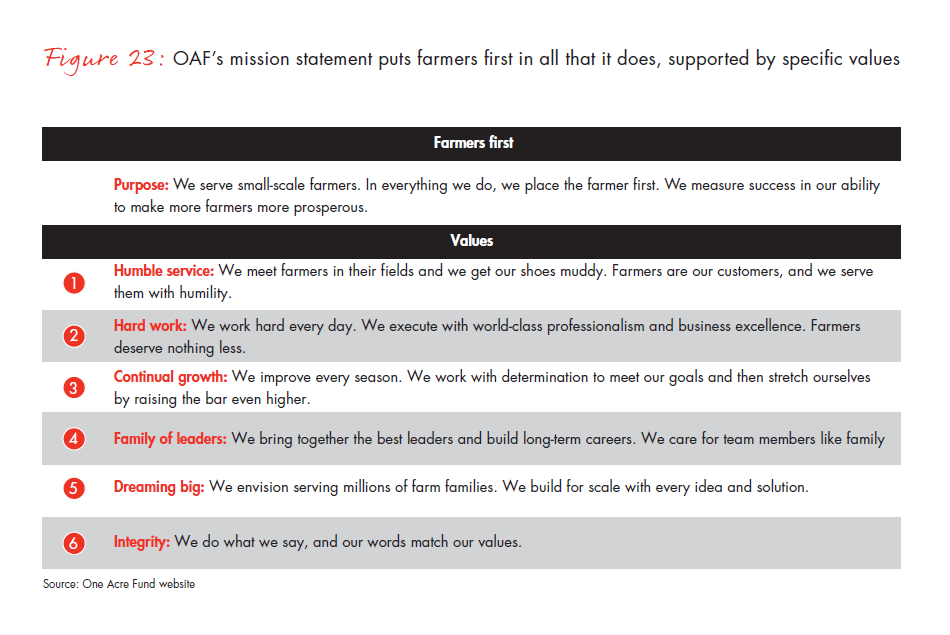
Adapt
Adapting OAF’s model starts with rigorous tracking of the KPIs that the organization has defined for its more than 2,000 field officers. These include metrics related to policy adherence—such as meeting attendance and number of members who have used OAF inputs; agriculture knowledge, such as planting- and topsoil-quiz scores; repayment rates, including collections to date and weekly collections; and logistics, such as distances that members have traveled to pick up inputs. OAF tracks these on a weekly basis, conducts annual customer satisfaction surveys and gathers data on satisfaction from customer call centers. The organization uses these data to make decisions about promotions, incentives and, when necessary, terminations of low performers. These metrics also shape how the company allocates its resources and responds to changing customer dynamics and growing conditions.
Performance on KPIs is completely transparent to field officers. As Kiette Tucker, director of operations for Kenya, put it, “Tracking metrics is crucial to our business; field officers can recite their recent KPIs.”
OAF invests heavily in learning and innovation. It uses a customer data-driven approach to continually refine its core product and inform decisions about innovation. Every year, it surveys several customers per field officer and conducts a text-based survey of its customers to understand usage patterns and how it could improve its services. The organization maintains a dedicated innovation team supported by an $11.6 million grant from the Bill & Melinda Gates Foundation. Across its operations, OAF is currently testing 40 high-potential technologies, with the goal of rolling out four of the most promising to as many as 200,000 farmers. Prospective innovations may take the form of seed sample packs and new varieties of particular crops, as well as new services like funeral and drought insurance. Every innovation goes through a rigorous, multiphase trial process. “We have eight bean varieties and eight maize varieties we are working with, and we hope in the following seasons we will be delivering [new] seeds to farmers … We are strengthening our ongoing experiments in storage, using bags to avoid post-harvest losses … and in composting by encouraging our farmers to not only use chemical fertilizers but to mix it with organic fertilizer, too,” explains Emmanuel Habineza, director of innovations for Rwanda.9
The ability to adapt its model was crucial to the organization’s survival in Kenya in 2013. Previously, OAF had predominantly provided maize seeds to farmers in Kenya. At the end of the 2012 season, however, farmers began seeing their maize wilt and die in the field. After an international research effort, the cause of the blight was identified as a new, rapidly spreading maize disease. Owing to the risk of planting maize in 2013, OAF decided to offer farmers a diversified package that included millet, sorghum, sweet potatoes, beans and cassava. But maize is an extremely popular crop in Kenya and some farmers decided not to work with OAF because they did not want to plant different crops. Changing the package reduced OAF’s planned scale for 2013, but the firm was still able to reach 60,500 families in Kenya, and the loan package allowed those farmers to mitigate the risk of the maize disease. Across western Kenya, OAF farmers reported strong millet and sorghum harvests.10
Results
OAF’s rigorous attention to building and executing a Repeatable Model has led to promising results (see Figure 24). In just four years—2009 to 2013—the number of farmer families the organization served grew tenfold, from 12,000 to nearly 130,000. The number of acres cultivated with its products increased from 6,000 to 91,000 during the same period. OAF is on track to reach a total of 200,000 farmers by the end of 2014 and to have 137,000 acres under cultivation. The organization has achieved particularly notable scale in Kenya (61,000 customers) and Rwanda (54,000 customers) and has gained significant traction in Burundi and Tanzania. Due to its continuous learning process, OAF has been able to achieve scale more quickly in each new market it enters (see Figure 25).
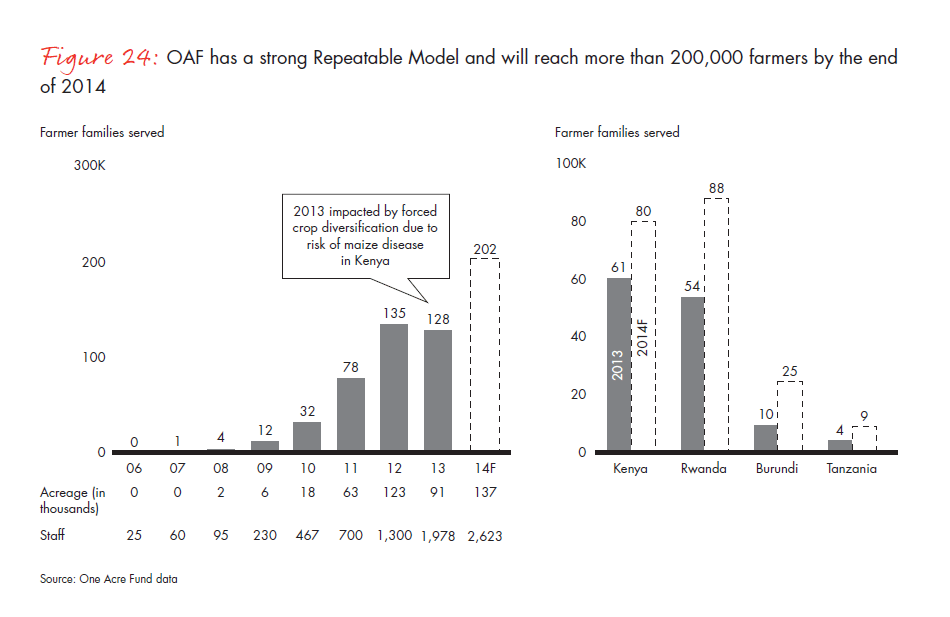
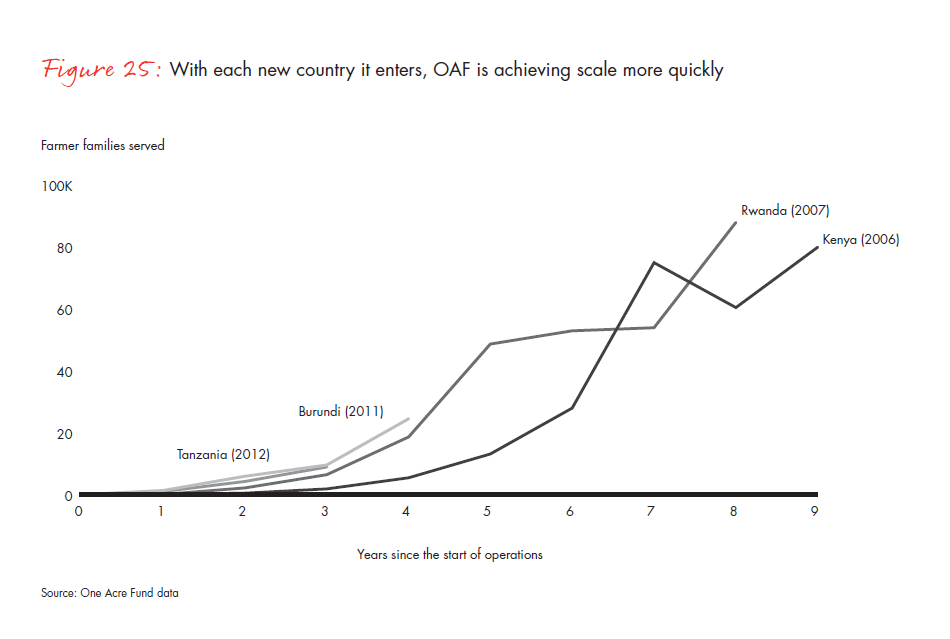
Learning loops in practice
It may seem that the path to building a Repeatable Model has been a straightforward one for Juhudi Kilimo, OAF and Sidai (see below), but nothing could be further from the truth. Each of these businesses has figured out how to build Repeatable Models only by failing often—but failing smart. The key is in the iterative learning loops: to fail, to diagnose why the failure occurred, to modify the model as required and to start again. GEWP is in the process of doing this now.
In 2008, Juhudi Kilimo closed two offices. These offices were serving a region that was surrounded by two national parks; there, the farmers were not as familiar with the microfinance model, and dairy farming was less common than elsewhere. One of the branches had numerous issues with fraud, as well as a management team that was unable to hire and retain the required frontline staff. Both of these experiences taught Juhudi Kilimo key lessons that shaped its Repeatable Model. The first branch closing showed the firm the importance of conducting due diligence on a region to assess the size of the addressable market; Juhudi Kilimo’s standardized market entry assessment tool was expanded, in part, as a result of this particular branch failure. The second branch failure emphasized the importance of strong middle management. Soon after, Juhudi Kilimo started investing in its HR efforts to more effectively identify, recruit, train and mentor branch managers who perform well and align to the firm’s values.
As Stephanie Hanson of OAF said, “Everything we have gotten right is a result of getting it wrong first.” In 2010, OAF had a pilot in southern Ghana. The firm soon found that the farmers there were not interested in growing maize, OAF’s focus crop. OAF then moved to the north of the country, home to more maize farmers, but realized that the market was simply too small. The OAF management then decided to stop its Ghanaian operations entirely so that they could devote more attention to markets promising the critical mass of farmers required to justify investment in the distribution network. The Ghana experience taught OAF how to better assess a market and quantify its potential. Importantly, the firm took the time to reflect on what did and did not work and shared these lessons and how they informed their operating model and expansion strategy with all of the senior team.
GEWP has realized that it must approach its expansion much more deliberately. Indeed, entering a new state is like entering a new country. As a result, GEWP has retrenched to Maharashtra and Karnataka, where it retains good name recognition, a solid network of more than 135 dealers and over 180,000 existing customers. It is focusing on Karnataka, because the desperate water shortage there means that many farmers must use drip irrigation to continue their operations. In each market, it is now focused on expanding a Repeatable Model more slowly but also more thoughtfully. To reap greater benefits from scale economies, it is now seeking the capital to own the manufacturing of KB Drip tapes.
One of the key lessons of building Repeatable Models is that it takes time and requires (and sometimes tests) the patience of those who work with, invest in and support pioneer firms. Particularly in the agricultural context, given the diversity of growing conditions, variety of crops and unpredictability of Mother Nature, it can take years to figure out what works and what doesn’t, how to customize the value proposition and how to best harness the Four A’s to spur adoption. It is this deliberate period of developing, testing and refining the model that can allow for explosive growth once the Repeatable Model is in place (see Figure 26).
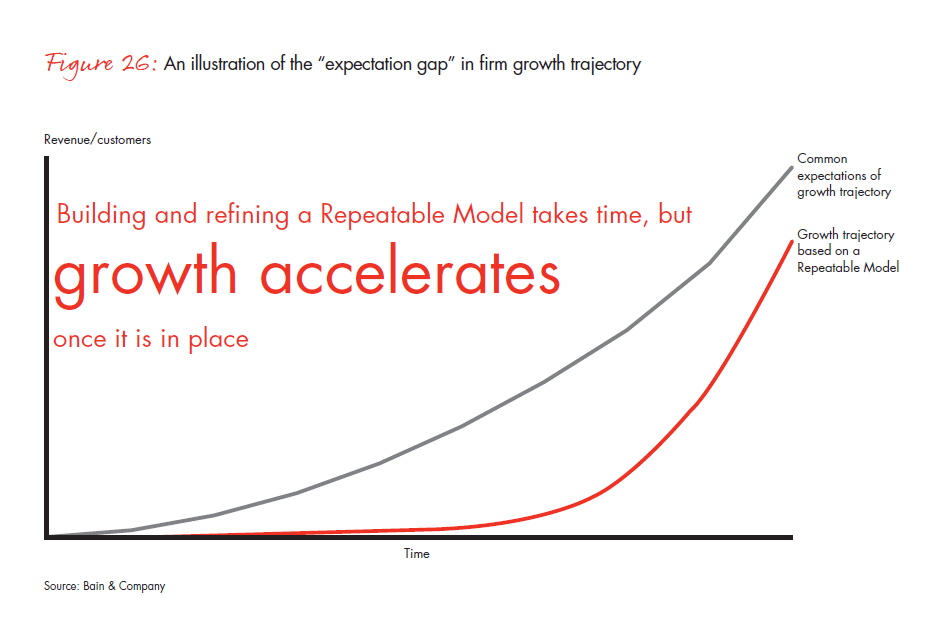
NEXT · CHAPTER 5 · Market systems: Implications for other actors
How Sidai is building its network of livestock service centers
Sidai operates livestock service centers—both company owned and franchises—in Kenya. The centers sell livestock inputs (including vaccines and feeds) as well as crop inputs (fertilizers and seeds). The centers’ veterinarians and animal-health technicians also visit farms, providing services to ensure that farmers make good use of these inputs. Founded in 2011, the firm has already opened six company-owned locations and 70 franchised centers. It hopes to grow this network to at least 150 service centers by 2015.
The company’s use of a modern retail format for its service centers lies at the core of its Repeatable Model of delivering quality products and services. The format gives shoppers open access to products on shelves, and well-informed sales staff can assist them in making the right selections.
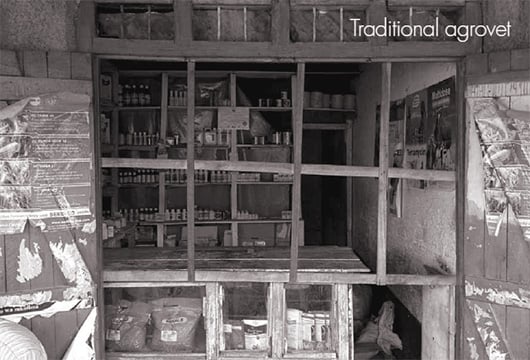
Sidai enters markets that lack adequate livestock services by setting up a company-owned store and then expands by opening franchises in the contiguous region. The company-owned stores are hubs for the network of franchised locations, serving as warehouses and sourcing centers. The company’s locations are also centers of expertise that provide technical advice and training for franchisees. To ensure the lowest cost for products sold by franchisees, the company takes advantage of the network’s size to obtain products from major suppliers. As Anthony Wainaina, the company’s managing director, explains: “There is demand for Sidai’s services all over Kenya. We open franchises based on where the costs can be managed, particularly distribution.” As the founder and chairman, Christie Peacock, noted, “We want to make money and serve livestock keepers in underserved locations and so open in some prime locations close to milk collection hubs. However, we also operate in remote parts of the far north of Kenya where there are thousands of livestock receiving no regular attention.”
Recognizing that its network is only as strong as its franchisees, Sidai “hardwires” its value proposition into the organization through a disciplined franchisee-selection process. The company identifies prospects in targeted markets and conducts due diligence on the promising candidates. Specific selection criteria include references from farmers, suppliers, banks and community leaders, as well as high performance in a previous trading business and genuine interest in working with farmers. Franchisees seeking to start their first business must produce a basic written business plan and have access to at least 20% of the required start-up capital. Short-listed applicants are interviewed directly by the company’s managing director and chairman.
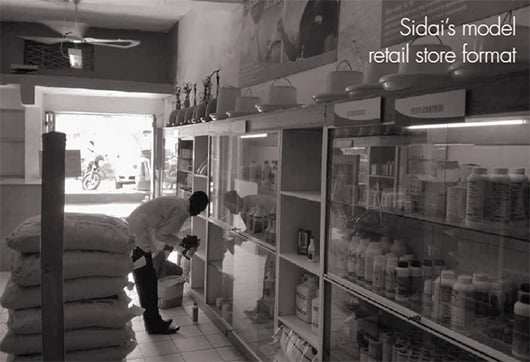
When entering a market, Sidai uses a standard set of methods to build its brand and promote awareness. Local radio ads introduce and reinforce the firm’s quality and service promise and tell listeners where to find the nearest store. The firm uses “field days” to showcase new products and provide basic training for franchisees, and it conducts seminars to train selected farmers on specific agricultural practices. It also forms partnerships with NGOs and suppliers to further expand its outreach.
Balancing regional needs and centralized quality standards is critical to the model’s success. Sidai uses franchisees’ feedback to tailor its product offerings to each region’s geography, crops, soil and types of livestock. At the same time, it also applies centralized quality standards to ensure that manufacturers provide high-quality products. “We reach customers through the franchisees who tell us the products customers ask for, but everything in the store must conform to our quality standards,” explains Peacock.
To enable this model to deliver results across its expanding network, Sidai has invested in building a management team and board with deep experience in business as well as livestock services. For example, its operations director is a veterinarian with experience in marketing and sales of veterinary pharmaceuticals and crop inputs in Kenya and other regions in eastern Africa.
As Sidai looks to the future, it will continue to build its hub-and-spoke model with company-owned stores supporting up to 20 to 30 franchises in densely populated regions. The aim is to first cover as much of Kenya as possible and then move into adjacent markets in other countries once it has carefully assessed the demand and its ability to operate successfully.
A checklist: Repeatable Models
The questions below will help to facilitate the application of the ideas and principles outlined in this brief, and guide pioneer firms in building and executing Repeatable Models.
Focus
- When was the last time that you had a deep discussion about your “core” with your team?
- How certain are you that your management team and front line can articulate your core?
- What makes your company uniquely differentiated, now and in the future?
- Measurable
- Tangible
- Decisive advantage
- How do you measure your penetration of your core market?
- What systems and processes do you have in place to assess adjacency growth?
- Are you seeing the costs and risks of complexity? How are you managing these?
Embed
- What are the few most critical frontline routines that really drive strategy and your differentiation?
- How thoroughly have your frontline employees adopted these routines?
- Do you have key metrics in place that tell you and your employees how well they are delivering against the strategy?
- Do you have metrics in place that signify whether and when you should consider growing to a new area?
- What are your market entry routines?
Adapt
- How much time is lost between decisions, actions and market feedback?
- Do you have learning systems in place that take into account regular input from customers and the front line?
- Do you have systems to step back and address the biggest threats to your current model?
- Have you set up clear structures and processes to continually innovate and capitalize on emerging growth opportunities?
Invest
Do you have a financing strategy that considers the types of capital available to, and required by, your organization at different stages of its growth?
Is the technology your business is using enabling or defining it (i.e., are technology solutions designed around your processes, or vice versa)? How scalable are your technology platforms?
Do you have the right leadership in all parts of your business? How strong is your middle-management “bench depth?” How are you attracting, developing and retaining top talent across your business?
1 Harvey Koh, Ashish Karamchandani, Robert Katz, From Blueprint to Scale: The Case for Philanthropy in Impact Investing, Mumbai: Monitor Inclusive Markets/Acumen, 2012.
2 The addressable market is defined as non-subsistence smallholder farmers in areas with a flat terrain and an accessible water source.
3 Chris Zook, “Desperately Seeking Simplicity,” hbr.org., February 2012, http://blogs.hbr.org/2012/02/desperately-seeking-simplicity/.
4 Chris Zook and James Allen, “The Great Repeatable Business Model,” Harvard Business Review, November 2011.
5 Chris Zook and James Allen, “The Great Repeatable Business Model,” Harvard Business Review, November 2011.
6 Any real or perceived business behavior that takes advantage of the poor can have significant consequences for the industry, as the Indian microfinance industry saw in 2010. Based on accusations of unfair and predatory lending practices resulting in farmer suicides in the state of Andhra Pradesh, the state government made the distribution and collection of loans at peoples’ homes illegal, halting the significant industry growth that had been experienced in the past 10 years. For more, see Vijay Mahajan and T. Navin, Microfinance in India: Lessons from the Andhra Crisis, Heidelberg: Springer Berlin Heidelberg, 2013.
7 Bain research has shown that the best measurement of customer loyalty comes from the answer to a simple question: “How likely are you to recommend [my product, service or company] to a friend or family member?” This question probes both dimensions of loyalty: the “head” (e.g., best features, best service, best price) and the “heart” (e.g., they know me, they value me, they listen to me, they share my values) and is often the strongest predictor of actual customer behavior: Promoters consume more of the product or service, stay longer as customers, make more referrals and complain less. As a result, companies with more promoters and higher NPS are often able to outperform their competitors in profitable growth.
8 We have focused on OAF’s Kenyan operations throughout but aimed to provide information on regional differences where appropriate.
9 See “Catching Up on Innovations in Rwanda,” One Acre Fund blog webpage, http://www.oneacrefund.org/blogs/tag/rwanda/80/P16.
10 Text adapted from OAF’s 2013 Annual Performance Report. See http://www.oneacrefund.org/uploads/all-files/One_Acre_Fund_Annual_Performance_Report_2013.pdf for more details.














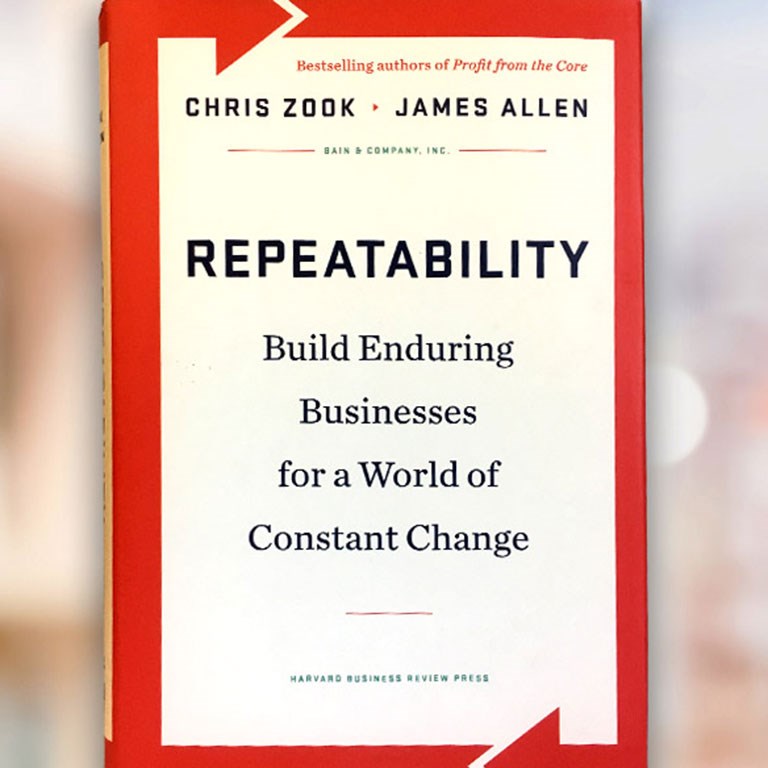
Repeatability
Learn more about how executives use Repeatable Models® to build enduring businesses.